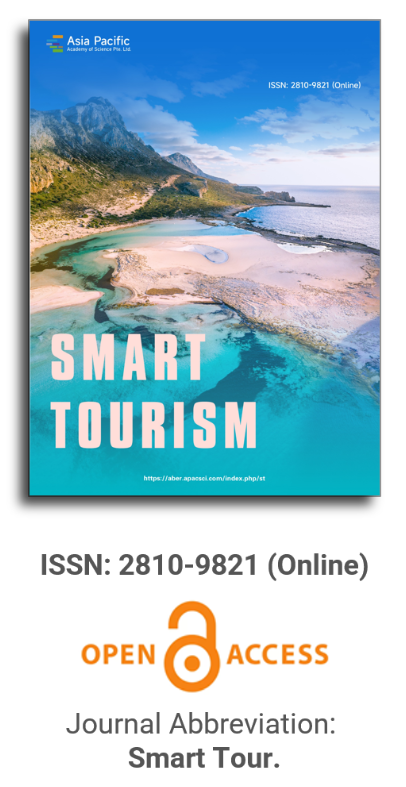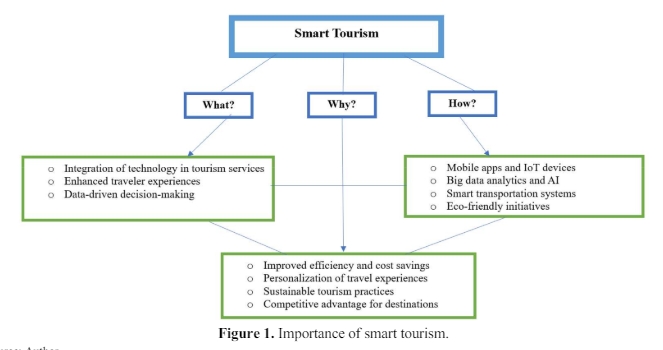


Trends in cultural tourism
Vol 4, Issue 1, 2023
Download PDF
Abstract
The objective of this paper is to reflect on the characteristics of the growth of world tourism and its relationship with the development of cultural tourism. The coming years will be marked by a steady increase in visitors, with diverse demographic, geographic, functional and cultural perfiles. Under the paradigm that cultural tourism should contribute to the improvement of the quality of life of all those involved, this paper proposes different lines of action that contribute to the sustainability of the cultural and tourism sector. The paper addresses other trends such as the need for balance between marketing and planning, the collective construction of tourist images, the current importance of intangible heritage or the growing presence of new technologies in all aspects of cultural tourism.
Keywords
References
- Cheer JM, Milano C, Novelli M. Tourism and community resilience in the Anthropocene: Accentuating temporal over tourism. Journal of Sustainable Tourism 2019; 27(4): 554–572.
- Prats L. Heritage and its feasibility in tourism terms. Revista de Turismo y Patrimonio Cultural 2011; 9(2): 249–264.
- UNWTO. Tourism and cultural synergies. Available online: http://www2.unwto.org/pub lication/tourism#and#culture#synergies (accessed on 20 October 2022).
- UNWTO. Tourism for Development—Volume I: Key Areas for Action. UNWTO; 2018.
- Timothy DJ. Making sense of heritage tourism: Research trends in a maturing field of study. Tourism Management Perspectives 2018; 25: 177–180.
- Richards G. Culture and tourism: Natural partners or reluctant bedfellows? A perspective paper. Tourism Review 2019. In Press.
- Richards G. Cultural tourism: A review of recent research and trends. Journal of Hospitality and Tourism Management 2018; 36: 12–21.
- Du Cros H, McKercher B. Cultural Tourism, 2nd ed. Routledge; 2015.
- Ivanovic M. Cultural Tourism. Juta and Company Ltd; 2008.
- Origet du Cluzeau C. Le Cultural Tourism (French). Presses Universitaires de France; 1998.
- Pulido JI, Calle M, Velasco M. Cultural Tourism (Spnaish). Síntesis; 2013.
- Smith MK. Issues in Cultural Tourism Studies, 3rd ed. Routledge; 2016.
- Timothy DJ. Cultural heritage and tourism: An Introduction. Channel View Publications; 2011.
- Abellán AC. Cultural Tourism and Sustainable Development: Analysis of Heritage Areas (Spanish). Universidad de Murcia; 2001.
- Nogués AM (editor). Culture and Tourism (Spanish). Signatura; 2003.
- Raj R, Griffin K, Morpeth N (editors). Cultural Tourism. CABI International; 2013.
- Sigala M, Leslie D (editors). International Cultural Tourism: Management, Implications and Cases. Elsevier; 2005.
- Smith MK, Robinson M (editors). Cultural Tourism in a Changing World: Politics, Participation and (Re)presentation. Channel View Publications; 2006.
- Smith MK, Richards G (editors). The Routledge Handbook of Cultural Tourism. Routledge; 2013.
- Timothy DJ, Nyaupane GP (editors). Cultural Heritage and Tourism in the Developing World: A Regional Perspective. Routledge; 2009.
- Moragues Cortada D. Tourism, culture and development (Spanish). Available online: http://bibliotecadigital.aecid.es/bibliodig/es/catalog o_imagenes/grupo.cmd?path=1000168 (accessed on 15 October 2022).
- McIntosh A, Prentice R. Affirming authenticity—Consuming cultural heritage. Annals of Tourism Research 1999; 26(3): 589–612.
- Pastor-Alfonso MJ. Cultural heritage as a tourist option (Spanish). Horizontes Antropológicos 2003; 9(20): 97–115.
- Prats L. Heritage + tourism = development? (Spanish). Revista de Turismo y Patrimonio Cultural 2003; 1(2): 127–136.
- Richards G. Production and consumption of European cultural tourism. Annals of Tourism Research 1996; 23(2); 261–283.
- Santana Talavera A. Cultural heritage and tourism: Reflections and doubts of an anfitrion (Spanish). Revista Ciencia y Mar 1998; (6): 37–41.
- Silberberg T. Cultural tourism and business opportunities for museums and heritage sites. Tourism Management 1995; 16(5): 361–365.
- Stebbins RA. Cultural tourism as serious leisure. Annals of Tourism Research 1996; 23(4): 948–950.
- Lehman K, Wickham M, Fillis I. A cultural tourism research agenda. Annals of Tourism Research 2014; 49: 156–158.
- McKercher B, du Cros H. Cultural Tourism: The Partnership between Tourism and Cultural Heritage Management. The Haworth Hospitality Press; 2002.
- Garau C. Emerging technologies and cultural tourism: Opportunities for a cultural urban tourism research agenda. In: Bellini N, Pasquinelli C (editors). Tourism in the City: Towards an Integrative Agenda on Urban Tourism. Springer; 2016. pp. 67–80.
- UNWTO. World tourism barometer. (Excerpt No. 17–1). Available online: http://cf.cdn.unwto.org/sites/all/files/pdf/unwto_bar om19_01_january_excerpt.pdf (accessed on 15 October 2022).
- UNWTO. Tourism towards 2030: Global overview. Available online: https://www.e- unwto.org/doi/book/10.18111/9789284414024 (accessed on 15 October 2022).
- OECD. OECD Tourism Trends and Policies 2018. OECD Publishing; 2018.
- Wall G, Mathieson A. Tourism: Change, Impacts, and Opportunities. Pearson Education; 2006.
- Milano C, Cheer J M, Novelli M. Overtourism: Excesses, Discontents and Measures in Travel and Tourism. CABI; 2019.
- Gratton L, Scott A. The 100-Year Life: Living and Working in an Age of Longevity. Bloomsbury Publishing; 2016.
- IOM. 2018 World Migration Report (Spanish). Organización Internacional para las Migraciones; 2018.
- Maalouf A. In the Name of Identity, 5th ed. Alianza Editorial; 2012.
- Pollock DC, Van Reken RE. Third Culture Kids: The Experience of Growing up among Worlds. Nicolas Brealey Publishing; 2009.
- Globetrender. From Boomers to Gen Z: Travel trends across the generations. Available online: https://globetrender.com/2017/05/19/travel-trends- across-generations/ (accessed on 15 October 2022).
- Hostelworld. The evolution of the hostel traveller. Available online: https://www.hostelworldgroup.com/~/media/Files/H / Hostelworld-v2/reports-and-presentations/the- evolution-of-the-hostel-traveller.pdf (accessed on 15 October 2022).
- Expedia Group. Generation alpha & family travel trends. How the world’s youngest generation is influencing family travel [Internet]. Available online: https:// info.advertising.expedia.com/family-travel-trends- generation-alpha (accessed on 15 October 2022).
- Fernandes F. Touristification and hospitality dynamics: The case of Lisboa. Revista de Turismo y Patrimonio Cultural 2019; 17(6): 1179–1189.
- Ivars-Baidal JA, Celdrán-Bernabeu MA, Mazón J, et al. Smart destinations and the evolution of ICTs: A new scenario for destination management? Current Issues in Tourism 2019; 22(13): 1581–1600.
- Thanou A, Tsiropoulou EE, Papavassiliou S. Quality of experience under a prospect theoretic perspective: A cultural heritage space use case. IEEE Transactions on Computational Social Systems 2019; 6(1), 135–148.
- Mondragón Mejía JA, EnseñatSoberanis F, Blanco Gregor R. Crowding perception as an indicator of sustainable management of cenotes for tourist use in Yucatan, Mexico. Revista de Turismo y Patrimonio Cultural 2019; 17(6): 1143–1158.
- Io MU. Understanding the core attractiveness of performing arts heritage to international tourists. Tourism Geographies 2019; 21(4): 687–705.
- Espinosa Ruiz A, Bonmatí Lledó C (editors). Manual on Accessibility and Inclusion in Museums and Cultural and Natural Heritage Sites (Spanish). Trea; 2013.
- Darcy S, Dickson TJ. A whole–of–life approach to tourism: The case for accessible tourism experiences. Journal of Hospitality and Tourism Management 2009; 16(1): 32–44.
- Michopoulou E, Darcy S, Ambrose I, et al. Accessible tourism futures: The world we dream to live in and the opportunities we hope to have. Journal of Tourism Futures 2015; 1(3): 179–188.
- Rinne A. In the age of the tourism backlash, we need “destination stewards”. World Economic Forum. Available from: https://www.weforum.org/agenda/2019/03/heard-of- destination-stewardship-its-the-future-of-tourism/ (accessed on 15 October 2022).
- Skift. Megatrends defining travel in 2019. Skift Magazine 2019; 12.
- Govers R. Our tourism system is broken—Time to customize. World Economic Forum. Available online: https://www.weforum.org/agenda/2019/07/tourism– trends/ (accessed on 15 October 2022).
- Richards G. Tourism Trends: The Convergence of Culture and Tourism. Academy for Leisure NHTV University of Applied Sciences; 2014.
- Oliveira NCD. The symbolic construction of the image of the territories: The Serra da Estrela between the traditional images and the tourist image. Revista de Turismo y Patrimonio Cultural 2019; 17(6): 1159–1177.
- Santana O, Joukes V. Images of the Douro destination in tourist guides from the second half of the twentieth century to the present. Revista de Turismo y Patrimonio Cultural 2019; 17(6): 1227–1243.
- Santana Talavera A. Imagining image on tourism: A trip back and forth. Antropología Experimental 2015; (15): 37–53.
- Garau C. 2016. Emerging technologies and cultural tourism: Opportunities for a cultural urban tourism research agenda. In: Bellini N, Pasquinelli C (editors). Tourism in the City: Towards an Integrative Agenda on Urban Tourism. Springer; 2016. pp. 67–80.
- Gómez Aragón A, Agudo Torrico J. Landscapes and imaginaries in tourist’s perceptions of Andalusia. Revista de Turismo y Patrimonio Cultural 2019; 17(6): 1217–1226.
- Roigé X, del Marmol C, Guil M. The uses of intangible heritage and the promotion of tourism in the Catalan Pyrenees. Revista de Turismo y Patrimonio Cultural 2019; 17(6): 1113–1126.
- Pardo CAH, Sánchez CB. Religious mega-events in Mexico: Tourist management of the Papal visit to the city of Morelia in 2016. Revista de Turismo y Patrimonio Cultural 2019; 17(6): 1245–1270.
- De Godoy R. The “tourist anthropologist” and archeology in Brazil: From rhetoric to practice. Revista de Turismo y Patrimonio Cultural 2019; 17(6): 1191–1204.
- Jiménez de Madariaga C, SeñoAsencio F. “We are brand.” Tourism and UNESCO brand in the Intangible Cultural Heritage. Revista de Turismo y Patrimonio Cultural 2019; 17(6): 1127–1141.
- Palomino B, López G. Relationships of nature tourism, communality and resilience in the Sierra Norte de Oaxaca, Mexico. Revista de Turismo y Patrimonio Cultural 2019; 17(6): 1205–1216.
- Epler Wood M, Milstein M, Ahamed-Broadhurst K. Destinations at risk: The invisible burden of tourism. The Travel Foundation; 2019.
- Govers R. Imaginative Communities: Admired Cities, Regions and Countries. Reputo Press; 2018.
Supporting Agencies
Copyright (c) 2023 Pilar Espeso-Molinero
License URL: https://creativecommons.org/licenses/by/4.0

This site is licensed under a Creative Commons Attribution 4.0 International License (CC BY 4.0).

Prof. Hung-Che Wu
Nanfang College, Guangzhou
China
Indexing & Archiving
Asia Pacific Academy of Science Pte. Ltd. (APACSCI) specializes in international journal publishing. APACSCI adopts the open access publishing model and provides an important communication bridge for academic groups whose interest fields include engineering, technology, medicine, computer, mathematics, agriculture and forestry, and environment.



.jpg)
.jpg)

.jpg)

